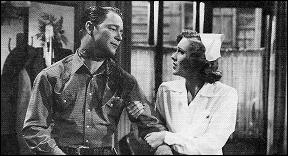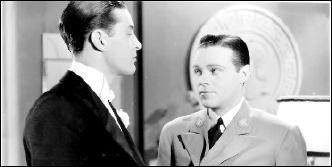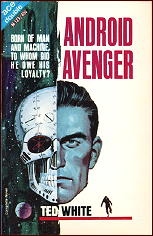FIRST YOU READ, THEN YOU WRITE
by Francis M. Nevins

Recently I became interested in LES INCONNUS DANS LA MAISON (STRANGERS IN THE HOUSE), one of Georges Simenon’s stand-alone crime novels that was published in France and made into a French movie during the Nazi occupation. More recently I got interested in another, which was also first published in occupied France and adapted into an Occupation-era movie. Unlike the vast majority of Simenons, LE VOYAGEUR DE LA TOUSSAINT (1941) has never been published in the U.S.
My copy, one of the rattiest-looking in my collection, is of Geoffrey Sainsbury’s English translation, STRANGE INHERITANCE, issued by Routledge & Kegan Paul in 1950. I read it a number of years ago and recently read it again and for the life of me I still don’t see why American publishers passed on it.
At 222 closely printed pages it’s almost twice as long as a Maigret and has far more characters, although many of them are onstage briefly if at all. The protagonist is 19-year-old Gilles Mauvoisin, whose parents, a pair of mediocre music-hall performers, died in a common accident in Norway. (The proper name of the city where they died is Trondhjem, sometimes Anglicized as Trondheim, but Sainsbury renders it as Trondjhem.)

Gilles is smuggled back into the French port of La Rochelle, where his closest relatives make their home, and discovers that his uncle, the wealthy and much-hated Octave Mauvoisin, died a few months earlier. Under Octave’s will Gilles inherits everything provided he live in the same house with Octave’s much younger widow. (This accounts for the English title.)
It soon develops that the widow had had a long-standing affair with a local doctor whose wife is an invalid. When that woman suddenly dies, the novel just as suddenly morphs into crime fiction as suspicion spreads around La Rochelle that she was poisoned by her husband—and that Octave Mauvoisin was likewise poisoned by his wife. Gilles, married by now to a girl his own age but clearly in love with the new-found aunt who is ten years his senior, sets out to clear her before she’s put on trial.
Almost in the Maigret manner, Gilles and a police detective he pays to take early retirement and become his personal PI reconstruct a typical day in Octave’s life and thereby, also in the Maigret manner (i.e. without the kind of clues we find in Anglo-American classic whodunits), identify the real murderer. Simenon never convinced me that Gilles is the teen he’s made out to be but I do recommend the book—if you can find a copy!—and hope to see the movie someday.
More than thirty years ago I discovered by accident that James Atlee Phillips, better known as Philip Atlee the author of the Joe Gall espionage novels, had moved to St. Louis County not far from me. Phillips was known as a curmudgeon who in all the years he’d been writing had never sat down for an interview but, having much more chutzpah in my younger days, I got in touch with him and, for reasons that are still obscure to me (perhaps because he was about to turn 70 and felt it was time to give an account of himself) he agreed to sit down with me and a cassette recorder. Our conversation, first published in Espionage magazine in 1985 and included in my 2010 collection CORNUCOPIA OF CRIME, is the source for almost everything published anywhere about his life.

It’s easy enough to find good discussions of his Joe Gall novels but not so easy to learn about his first whodunit, written in ten days and published back in 1942 when he was still in his twenties and not reprinted even at the height of the popularity of the Gall series. THE CASE OF THE SHIVERING CHORUS GIRLS sounds from its title like a Perry Mason exploit but you don’t have to read any further than the dust jacket copy to realize that this book’s protagonist is not a Mason clone but a cross between Nero Wolfe and Baynard Kendrick’s then popular blind sleuth Captain Duncan Maclain.
After losing his eyesight in an auto smashup, the distinguished diplomat Henry Morton Wardlaw decides to devote his life to solving crimes without leaving his lavish Manhattan penthouse, where he even grows flowers, which he can smell but can’t see. Like Wolfe and Maclain he needs a leg man, or we might say eyes and ears, which he obtains by hiring two associates: Emery Landers, a jobless young law graduate of the University of Colorado, and George Caster Patterson, a Mike Mazurki-like hulk with a flair for photography.
They call each other Emmy and Bopeep and, when not sleuthing for Wardlaw, whom for no particular reason they call Judge, they spend their time bantering and getting plastered. The less said of these characters, if you want to call them that, the better.
Apparently Wardlaw and his team have carte blanche from the NYPD to investigate any crime that strikes their fancy. In SHIVERING CHORUS GIRLS it’s the sudden death of a juggler while performing in a night club located in the basement of a hotel. To explain how Jim Phillips came to conceive this book I need to quote from our conversation.
“[I]n 1939 I went to work in New York for Billy Rose…at the World’s Fair, where his Aquacade played to about 14,000,000 people in two years….I was a second-string publicity man….It was our job to get the Rose name and the Rose activities in as many New York newspaper columns every day as we could….I did a lot of submissions to Dorothy Kilgallen, Winchell, Leonard Lyons. We would send five or six items to these columnists and one of them, preferably the most interesting, would have Billy Rose’s name in it, so if we were lucky we got to plug him.

“My office was in the Paramount Hotel on the mezzanine floor, and we had the whole basement of the hotel for the Diamond Horseshoe night club [which was owned by Rose].
“I also used to ream out acres of background stuff about newspapers blowing through Times Square around the statue of Father Duffy at midnight.â€
So much for the origin of the club in the hotel basement, and for the source of the countless “background stuff†passages such as this one from the beginning of Chapter Three.
“The sun was rising when they came out of the Jewel Box and caught a cab. The city was beginning to stir, and although it was not quite six o’clock, people were hurrying down the streets. The subway stations were coughing up a thin stream of humanity, and the streetcars were jangling through Times Square with sleepy-eyed people riding on them.â€
A few of these passages even mention the statue of Father Duffy. The juggler’s death turns out of course to be murder, by a poison needle inserted in one of his clubs. (Shades of the first Nero Wolfe novel! In FER-DE-LANCE, which first appeared in 1934, Wolfe investigates the death of a college president on a golf course and discovers that the handle of one of his clubs had been gimmicked with a poison needle.)
In due course there’s another poison needle murder, this one committed with a sort of blowgun connected to a clarinet, and then there’s a third, which is more conventional. Emmy and Bopeep also encounter an attempted kidnaping on a night subway and a plethora of other incidents before Wardlaw pieces together the whole farrago, which depends on a coincidence worthy of Harry Stephen Keeler.
Even if Jim had given us a sorely needed map of the club and its backstage layout, no one would call this book a masterpiece. But it’s routinely readable and in a few spots—principally the brutal police third-degree of a gangster—it’s quite effective. I’m proud to have known the author, especially since during one of our talks he signed my first edition, which I had picked up for 49 cents years before I got to meet him.

On a long-distance Amtrak trip last month I packed in my carry-on bag THE COUNT OF NINE (1958), one of the dozens of novels starring irascible Bertha Cool and ingenious Donald Lam that Erle Stanley Gardner wrote as A.A. Fair between 1939 and his death in 1970. The C&L detective agency is hired by wealthy big-game hunter Dean Crockett II to protect the items in his valuable collection from being ripped off during a forthcoming dinner party.
Bertha checks out all the guests but at the end of the festivities both a 4-inch-tall jade Buddha and a 5-foot-long blowgun are found to be missing. Lam tracks down these items in record time and returns the blowgun to Crockett’s penthouse, where it’s apparently used a few hours later to kill him.
As usual in Fair novels, detection takes a back seat to scam artistry, with Donald encountering a clever tax-evasion scheme and a repulsive photographer with a playbook full of devices to get women to sleep with him. He also encounters some jewel thieves whom he scams into prison cells after they beat him to a pulp. Finally we return to the Crockett killing. Battered but unbowed and thanks to reasoning that leaves much to be desired, Donald exposes a murder weapon almost as bizarre as Phillips’ deadly clarinet.
Anthony Boucher in the New York Times Book Review (June 15, 1958) said that “[t]he pace of the story is inimitably Gardneresque†and especially admired what he called “the adroitness with which Donald so arranges facts that homicide can reach the right answer for all the wrong reasons.†Either he saw something I missed or he was in an especially generous mood that day.




